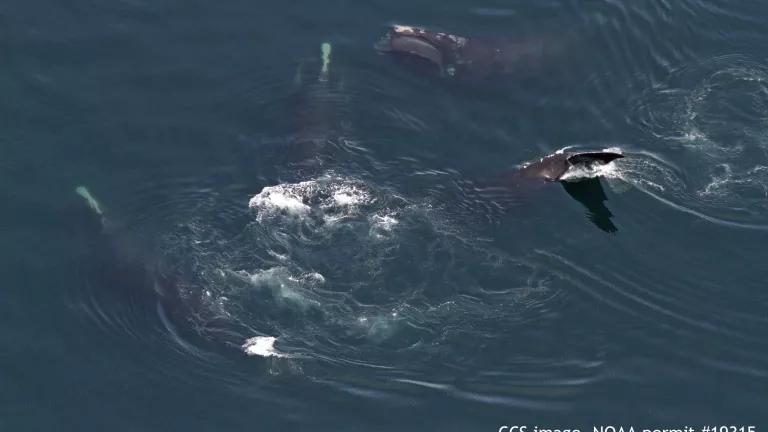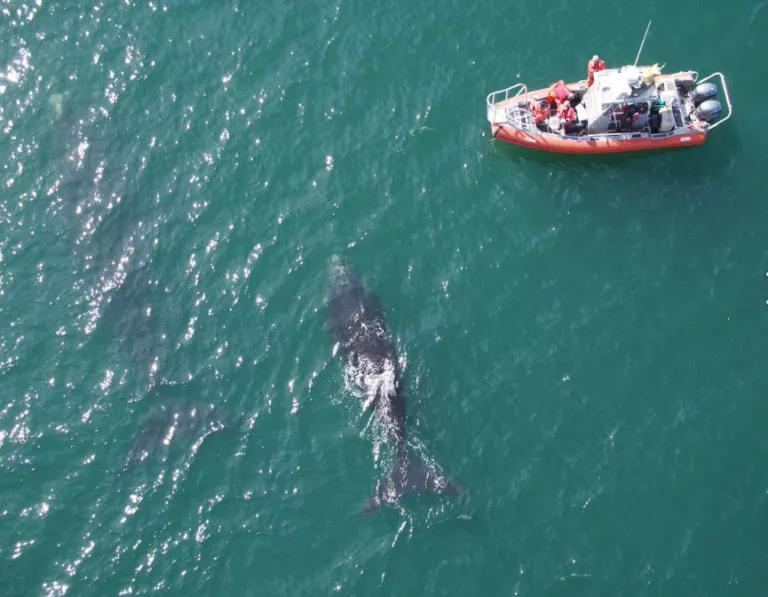
NRDC is thrilled to announce the release of “Best Management Practices for North Atlantic Right Whales During Offshore Wind Energy Construction and Operations Along the U.S. East Coast.” The best management practices were developed in close consultation with offshore wind developers and the many environmental organizations that have signed on in support.
Now more than ever, we must redouble our efforts to both fight climate change and protect our oceans. Given the urgency of the climate crisis, the Natural Resources Defense Council is working hard to advocate for all forms of clean renewable energy projects, including the nascent offshore wind industry.
We are also working to help prevent the North Atlantic right whale from extinction. The right whale is fighting for survival, with a dwindling population and a small number of breeding females. Their decline is due largely to entanglement in fishing gear and collisions with ships, but without protections from additional stress the species may not recover. Seven new calves have been recently sighted and represent new hope for the species, which saw at least 20 deaths over the past two years. We now need to do everything in our power to protect these whales if the species is to survive.
Knowing the pressure facing this species, groups have identified a path forward to advance the offshore wind industry in a manner that doesn’t place increased stress on right whales. These best practices include rigorous monitoring protocols for whales at the construction site, ship speed restrictions, and noise reduction measures, including restrictions on pile driving activities during times that right whales are most likely to be in the construction area. They also highlight the need for scientific research and long-term monitoring to advance our understanding of the potential effects of offshore wind development on marine and coastal resources in the U.S.
The best management practices advance NRDC’s duel goals of rapidly growing clean offshore wind power to fight climate change and protecting endangered ocean wildlife. As project developers complete state and federal environmental reviews, conservation groups like ours will be looking at what measures they pledge to take to mitigate their impact on North Atlantic right whales—these are the kinds of protections we will be looking for.
Knowing that every wind project operates under different environmental considerations, these management practices account for use of various kinds of fixed foundation offshore wind technologies and mitigation measures. For example, seasonal restrictions on construction are needed for foundations that are driven into the seafloor, whereas foundations that are installed more quietly—like gravity-based systems that are sunk onto the seafloor—may not require this restriction. By providing a range of mitigation measures to allow the various technologies to advance, we hope to give developers many options to meet the goal of right whale protection.

Paired with these general best practices is the recently announced right whale agreement signed by Vineyard Wind, NRDC, Conservation Law Foundation and National Wildlife Federation. This agreement provides a tangible example of how these principles can be applied. While the specificity found in this agreement wouldn’t fit the needs of all developers, together with the best management practices, it provides a template for offshore wind developers to follow.
Best management practices like this can help the industry advance while ensuring a healthy ocean environment. And speed is of the essence when it comes to transitioning our society to cleaner greener fuels. We need to embrace clean, well-paying industries like offshore wind while making sure to incorporate protections that will help defend our already stressed marine life.
NRDC looks forward to continuing to work closely with offshore wind industry and with our partners in the environmental and scientific communities to help advance offshore wind alongside ocean protection; these best management practices show that can be achieved.

